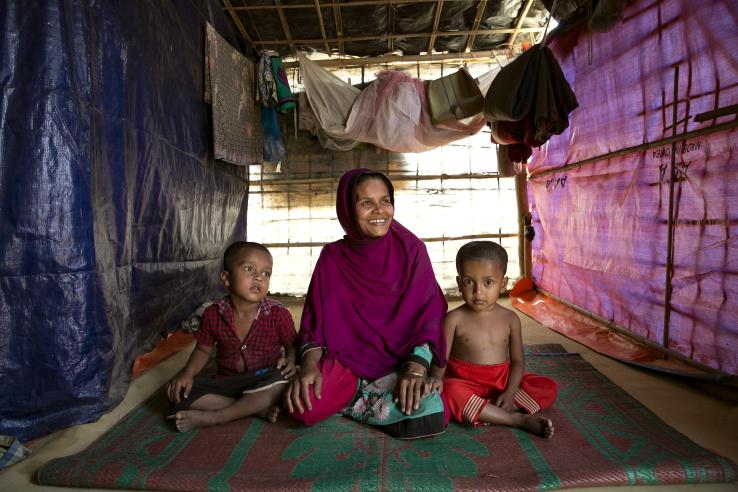Improving mental health in low- and middle-income settings: Key findings from rigorous research

This blog was initially prepared by the J-PAL Health Sector in 2023 to provide a high-level overview of evidence on improving mental health outcomes. It is not an exhaustive review of all the rigorous evidence on the discussed topics. Linxi Wang led development and drafting of this blog, while Frank Schilbach provided academic guidance.
Mental health conditions are prevalent worldwide, especially among people living in poverty. In 2017, an estimated 10.7 percent of the global population had at least one mental health disorder (this includes conditions such as depression, anxiety, bipolar disorder, eating disorders, and schizophrenia, but it does not include substance abuse). Depression and anxiety combined affected around 7.2 percent of the population, or more than 540 million people. And this mental health statistic may be an underestimate: mental health issues are widely under-reported.
The Covid-19 pandemic has also increased the prevalence of mental health illnesses such as depression and anxiety, which increased by 25 percent in the first year of Covid-19 alone. The consequences of poor mental health can be serious, as they are a significant contributor to disability and negative life outcomes among young people, especially girls.
Despite its pervasiveness, progress in improving mental health worldwide lags other areas of health. Stigma, prejudice, and discrimination against people with mental illness are widespread; people may choose not to seek care, fearing being treated differently. In some cases they may also not consider some conditions such as depression or anxiety to be something that could improve through treatment.
Meanwhile, access to services remains low even for those who seek care. In most countries, financial and human resources for mental health remain scarce and unevenly distributed. A World Psychiatric Association multinational survey in 2010 found that, "The treatment gap for people with mental disorders exceeds 50 percent in all countries of the world, approaching astonishingly high rates of 90 percent in the least resourced countries."
Evidence on how to close this treatment gap is relatively sparse across low- and middle-income countries (LMICs). This blog provides an overview of the evidence behind interventions that seek to improve poor mental health, as well as approaches that can address the underlying drivers of mental illness.
Psychosocial interventions, community approaches, and digital tools
One area of research in the mental health space focuses on improving outcomes for individuals with poor mental health. This section provides an overview of the evidence behind such programs in LMICs. It does not discuss medications to treat mental health: while they are critical, they may not be universally available, particularly in poorer or more rural parts of the world.
While psychotherapy has been effective in high-income settings, more research is needed on how to adapt such interventions to LMICs
Psychological interventions, particularly psychotherapy, are used to treat psychiatric disorders such as depression, anxiety, and post-traumatic stress, particularly in high-income settings. Typically delivered by a trained therapist, the World Health Organization (WHO) notes these programs involve “interpersonal or informational activities, techniques, or strategies to improve health functioning and well-being.” Evidence from high-income countries in Europe and the US show that these interventions can be impactful also for preventing depression. A systematic review from 2018 shows that cognitive behavioral therapy (CBT), a type of psychotherapy that involves challenging negative thoughts to alter behavior or treat mood disorders, had similar efficacy to many antidepressants.
However, delivering such interventions in many LMICs can be difficult due to lack of trained therapists, visits requiring long travel, or treatment incurring high medical costs. Stigma around discussions of mental health can be another barrier to seeking care.
While non-experts can be trained to deliver mental health services, evidence on what makes for effective trainings and who is well-placed to deliver these services is sparse and context-specific. It is crucial to consider local factors, including the cultural and social context of the target population, to ensure the intervention is tailored to their needs and addresses the root causes of mental health challenges.
Community outreach could help close the treatment gap
The WHO defines community mental health care as a network of interconnected services that typically include 1) mental health services that are integrated into general health care and 2) services that deliver mental health care and support access to social services. It usually involves task-sharing with non-specialized healthcare providers such as community social workers and peers. Such care can be financially and geographically more accessible than treatment via the formal health system.
The Healthy Activity Program (HAP) is one such community-based approach rooted in psychological science. Designed to be delivered by lay health workers, it is ideally provided in individual face-to-face settings, over five to eight sessions. In a trial in Goa, India, HAP effectively improved recovery rates in persons with severe depression in primary care at three months and at one year after treatment. A follow-up study four to five years later found the effects persisted: those in the program were 11 percentage points less likely to be depressed than the control group. Since then, these positive findings have been replicated in trials in other countries (for example, Nepal and Uganda) and the intervention has been adapted for use in high-resource settings (in the US and Canada). The EMPOWER program is currently deploying digital tools to enable front-line workers to learn, master, and deliver the treatment at scale in India and elsewhere.
Digital technology may be promising, but open questions on how to increase its use at scale
Digital tools that deliver mental health treatment, such as applications made for mobile phones, may be a low-cost way to close the treatment gap: after initial development, the scale-up and distribution of digital content could be extremely cost-effective. However, mental health apps often have limited effects, likely due at least in part to difficulty in motivating consistent use. A 2019 review found high dropout rates in clinical trials of smartphone apps for depressive symptoms, and rates may be even higher in real-world settings.
Combining digital tools and in-person sessions may be more effective. Syrian refugees in Turkey who followed a five-session stress management course developed by WHO, called Self-Help Plus, were 19 percentage points less likely to have any mental disorders six months after the program than those not participating in the program. Another study delivered this intervention to refugees and asylum seekers across multiple nations in Western Europe. Although it had no impact on the frequency of mental disorders, it did have an impact immediately following the program. Digital technologies can also promote healthy lifestyle behaviors like mindfulness, which several studies have shown can improve mental health.
Leveraging economic, physical health, and social interventions to address underlying causes
Programs that focus on addressing common causes of poor mental health, including those that provide economic support, improve physical health, and allow for more social interaction, may be important for preventing or reducing stress, depression, and anxiety.
Economic interventions may be key to improving mental health for people living in poverty
The relationship between poverty and mental illness is bidirectional. While poverty and other economic challenges can increase the risk of developing mental illness, mental illness can also cause economic challenges such as job loss or make an individual less likely to find work.
Many anti-poverty programs have increased happiness and decreased mental distress. For example, the Graduation Approach is a multifaceted program targeting people living in extreme poverty that has improved household income and consumption. The program also improved mental health outcomes across six countries where the program was implemented—Ethiopia, Ghana, Honduras, India, Pakistan, and Peru. Cash transfer programs have also elicited mental health benefits. A three-year follow-up study of an unconditional cash transfer program in Kenya found transfer recipients had higher levels of psychological well-being relative to non-recipients in the same village.
Improving physical health may be important for mental health, but more research is needed from LMICs
Around 30 percent of those with a long-term physical health condition are estimated to have a mental health condition. Randomized evaluations in high-income settings have shown physical exercise can combat depression, though little evidence exists on how to effectively implement such programs in LMICs.
A related topic is the role of sleep on mental health. A study in India found that higher-quality naps improved economic and psychological outcomes for urban low-income adults. Poor sleep is often correlated with mental distress, in part because poor sleep is also a common symptom of depression. Building on this study to better understand how to improve sleep in other contexts and who is most likely to benefit is important.
Loneliness can be a main cause of depression, particularly for elderly people, but more research is needed on which social interaction efforts could help combat it
Recent evidence has demonstrated that loneliness was one of the main causes of depression among elderly populations in LMICs. The Covid-19 pandemic similarly had a negative impact on the mental health of many, with a particularly severe impact on young adults, in part due to the closure of schools and colleges as well as restrictions on social interaction. There is little evidence on what kinds of programs and how much interaction is necessary for reducing loneliness.
More LMIC research on improving mental health programming and on stimulating demand for mental health is critical
While many mental health interventions have been developed and tested in high-income countries, there remain two broad areas for further research in LMICs. The first is to better understand how to deliver care and what interventions can be effective in LMIC settings. The second is on how to increase demand for these services, especially when it comes to overcoming stigma around mental health and normalizing treatment. Indeed, top reasons individuals do not seek treatment include not knowing what kind of help to seek, thinking that treatment would make no difference, and a preference for self-help. Access to mental health services is vital for improving overall well-being. By building the evidence base in these areas we can help to ensure that those in need of these services are able to access them and feel comfortable doing so.

